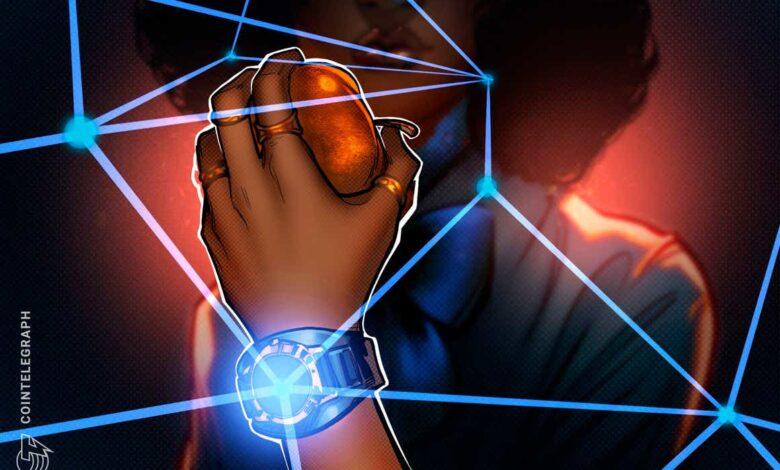Blockchain-enabled digital fashion creates new business models for brands

Nonfungible tokens (NFT) could also be disrupting the trillion-dollar style trade, however NFTs are only one piece of a a lot bigger puzzle that’s revolutionizing this sector. Moderately, blockchain expertise as a complete continues to be a game-changer for the style trade.
Whereas blockchain-based provide chains served as a few of the earliest use instances of how the expertise may assist detect fraudulent objects, digital wearables being constructed on blockchain networks are actually coming to play. Megan Kaspar, co-founder and managing director of Magnetic — a privately held crypto and blockchain funding and incubation agency — instructed Cointelegraph that digital style is a really highly effective use case for blockchain expertise. Nevertheless, she famous that many manufacturers stay unaware of the worth that blockchain can present by way of creating new enterprise fashions.
The rise of digital style and its impression
To be able to clarify the huge alternatives blockchain can convey to right now’s style world, Kaspar famous that every one manufacturers will initially transfer to a “digital-first” mannequin within the close to future:
“That is the place collections are created digitally first, whether or not in-house or outsourced to an organization. The digital-first course of reduces time, power and capital, all of that are not required to preview collections previous to manufacturing. The digital assortment can then be superimposed onto pictures by way of digital tailoring.”
To place this in perspective, Kaspar was just lately featured on the duvet of the January subject of Haute Residing. This was distinctive within the sense that it was the primary style journal cowl in america to show digital luxurious designer clothes on a human. Moreover, the Haute Residing cowl is supplied with QR codes that generate augmented actuality try-on capabilities, permitting readers to scan barcodes to see how every digital piece featured may look. The designs, which have been created by Fendi and digitized by DressX, can then be bought instantly on the Fendi web site.

Whereas revolutionary from a advertising and marketing perspective, there are different advantages of digital-first style. As an illustration, Adrienne Faurote, style director at Haute Residing, remarked in her function story that “the times of delivery over 20 trunks of clothes throughout the globe” are gone. This is a crucial level to contemplate, particularly because the COVID-19 pandemic has resulted in various provide chain points, equivalent to delivery containers getting delayed internationally.
It’s additionally essential to notice {that a} blockchain community will not be required in relation to digital-first fashions. Daria Shapovalova, co-founder of DressX, instructed Cointelegraph that whereas the Fendi clothes worn by Kaspar on the duvet of Haute Residing are utterly digital, they aren’t NFTs:
“With this primary digital cowl within the U.S., we aimed to advertise digital style to a mainstream viewers, making Fendi AR try-on capabilities obtainable to everybody — freed from cost. Releasing the objects as NFTs, then again, would imply that the digital property and AR would solely belong to the NFT holders, which might considerably restrict the viewers’s skill to work together with the digital clothes.”
In accordance with Shapovalova, whereas NFTs are able to bringing many alternatives to the digital style trade, equivalent to offering a way of belonging and a shortage impact, this was not what DressX supposed to attain with this particular marketing campaign. Kamal Hotchandani, chief working officer of Haute Media Group, added that the Haute Residing cowl demonstrates how mainstream publication options are shifting to the digital panorama, with the rise of shoppable editorials and augmented actuality (AR) try-on capabilities.
But when blockchain capabilities are utilized to this combine, the advantages grow to be far higher. For instance, blockchain expertise is enabling Web3 e-commerce between digital and bodily objects.
Justin Banon, co-founder of Boson Protocol — a decentralized commerce platform — instructed Cointelegraph that the corporate has developed a foundational base layer for Web3 that allows sensible contracts to execute e-commerce transactions inside digital, metaverse environments. Because of the capabilities offered by sensible contracts on Boson’s blockchain community, Banon mentioned that belief points that might probably come up in a metaverse setting may be resolved:
“For instance, if a person entered a metaverse and got here throughout one other avatar that was promoting a automobile, one might marvel how this transaction could be safe. Boson Protocol serves because the belief layer between the metaverse and the universe by enabling the sale of NFTs with encoded sport principle that may then be redeemed for real-world objects.”
Blockchain serving as a trusted layer between Web3 commerce transactions is important right here, particularly as main labels equivalent to Nike and Adidas arrange shops within the metaverse. Digitizing objects as NFTs turns into the following step required for promoting items in digital environments, which result in extra functionalities.
As an illustration, Kaspar defined that digital-first collections may be offered solely as NFTs after which later manufactured if a purchaser wishes to have the bodily objects: “Harnessing blockchain expertise and NFTs affords manufacturing amount, visibility of every garment and globally accessible for the primary time in historical past. Restricted-edition drops and on-demand manufacturing may simply be byproducts of Web3.”
Your distinctive RTFKT Punks Sneaker NFT will get you :
NFT 1/1 + 1 Pair of Bodily to forge June twenty second
VXL Portrait 1/1 (airdropped later we eliminated double minting to ease the chain a bit)
Voxel sneakers recordsdata for MetaverseAll created from your Punk https://t.co/B4YOKI0dV4 pic.twitter.com/7vOX0mRRLr
— RTFKT Studios (@RTFKTstudios) May 11, 2021
Banon added that whereas 2021 centered totally on manufacturers promoting NFT style, this 12 months will see an elevated push towards “digi-physical” or “phygitals.” In accordance with Banon, that is when manufacturers promote bodily style objects in Web3 ecosystems which might be related to NFT counterparts. “Suppose bodily sneakers with an NFT wearable model as properly,” mentioned Banon. This was just lately demonstrated by crypto style home RTFKT as the corporate collaborated with “CryptoPunks” to create 10,000 NFT sneakers. One customized sneaker pair was created for every “CryptoPunk” launched after which given to its rightful proprietor to put on.
The transparency offered by a blockchain community can also be helpful. For instance, Kaspar identified that limited-edition style drops attraction to sure shoppers. As such, it’s potential to grasp what number of objects actually exist throughout a blockchain community when they’re offered as digitized NFTs. This was demonstrated just lately when Dolce & Gabbana launched its nine-piece “Collezione Genesi” NFT assortment.
Though the Fendi assortment featured in Haute Residing’s January 2022 subject was not NFTs, Natalia Modenova, co-founder of DressX, instructed Cointelegraph that nonfungible tokens will present the following layer of utility inside the style trade:
“NFTs maximize alternatives and open up new realms for self-expression and creativity. We examine NFTs to high-end style or high fashion as a result of it offers a way of belonging, a shortage impact and a luxurious really feel, which might not in any other case be achieved within the digital world.”
How quickly will digital-first style be adopted?
Whereas digital-first fashions are able to offering the style trade with an a variety of benefits, there are challenges which will hamper adoption. As an illustration, whereas it’s notable how real looking the digital Fendi assortment seems on Kaspar, the quantity of labor required to create such an impact is huge.
Thus far, Modenova shared that the method of digitizing clothes is at all times depending on the supplies offered by the model. “All 9 Fendi outfits have been digitized from pictures, recreating the materials, patterns and silhouettes of the luxurious clothes within the 3D area from scratch,” Kaspar mentioned, including that every one parts of style design — equivalent to form, coloration, area, type, texture, and so forth. — play a basic position within the digitization of clothes to create an ideal visible design. As such, this course of requires professionalism that could be tough to acquire on condition that the area continues to be rising.
Associated: Unlocking utility is vital for style manufacturers launching NFTs in 2022
This problem doesn’t appear to be impacting the position that blockchain will doubtless proceed to play within the style sector. Hotchandani remarked that shifting ahead, Haute Residing plans to transform all of the journal’s covers into NFTs. “Our covers are items of artwork and content material related to that second in time, so I really feel creating NFTs of our covers provides our artwork one other expression and a everlasting dwelling on the blockchain.”
Modenova identified that the rise of the metaverse has resulted in “metafashion,” noting that digital property that have been as soon as solely used for gaming are actually being designed to decorate digital variations of people:
“Folks from tech and gaming backgrounds rapidly perceive this, however now, the mainstream is beginning to actively comply with. It is a frequent sample that arises when revolutionary merchandise are launched. Wearables are essentially the most pure extension of the metaverse and crucial pillar of the metaverse economic system.”




